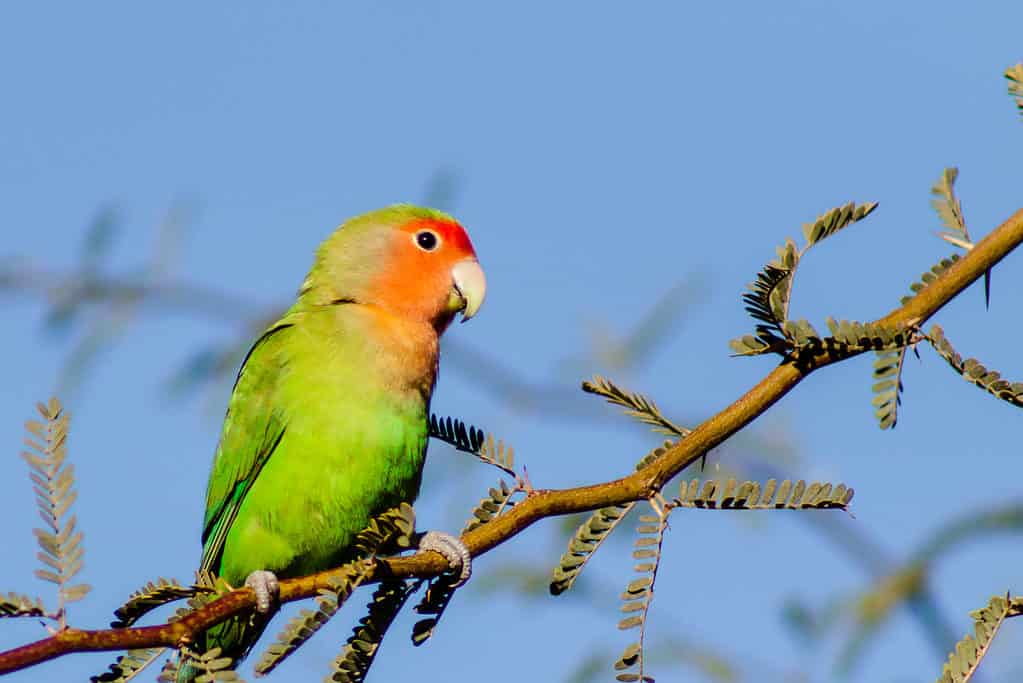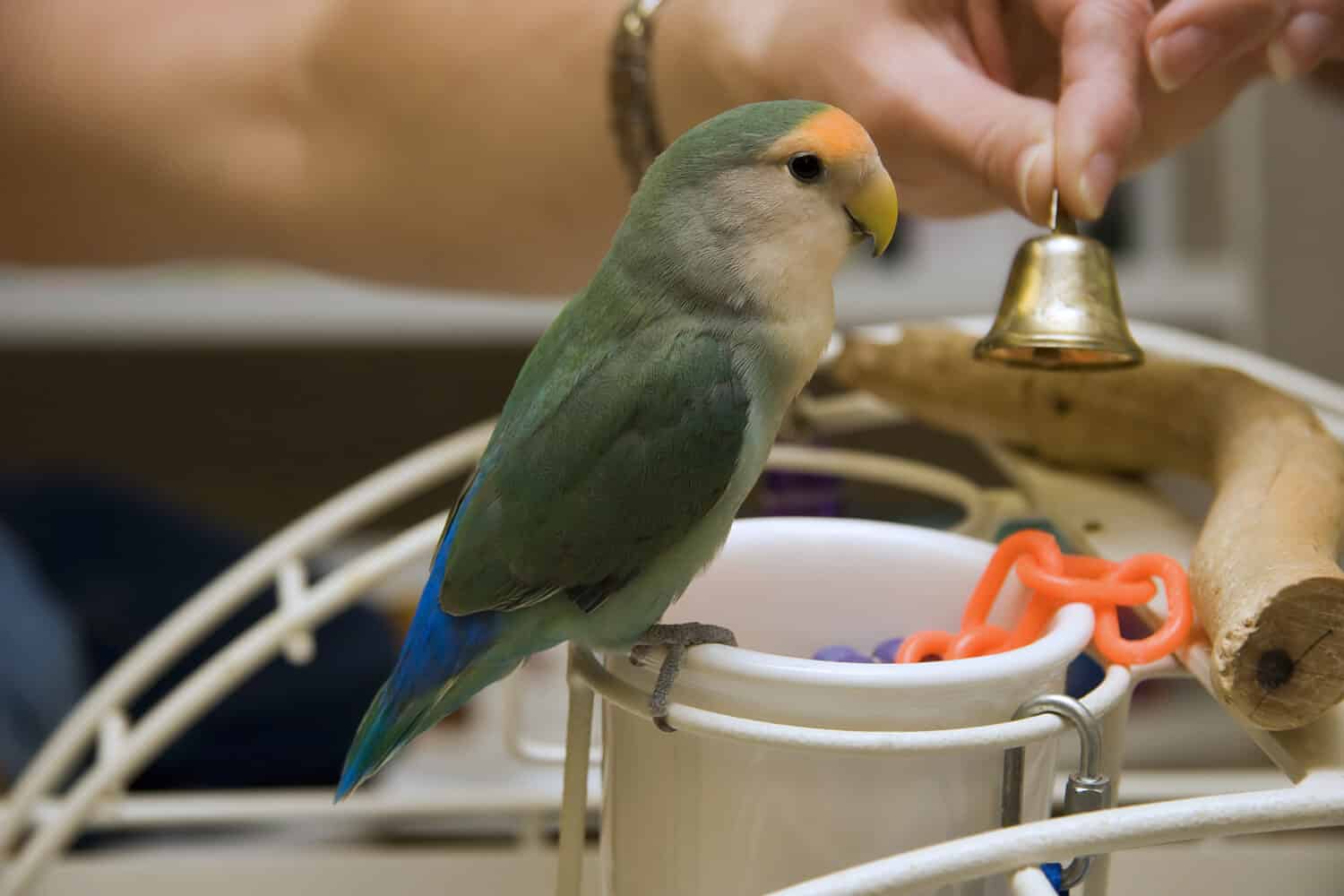No doubt you’re familiar with the term “lovebirds,” and you’ve likely used it to tease a friend who was inseparable from their significant other.
But do you realize that lovebirds — who get their name from their monogamous mating practice — actually make great family pets?
Lovebirds, which compose the Agapornis genus, are smart, social, and affectionate, and their strong natural bonding instinct extends to their human owners, too.
Hailing from Africa, the lovebird is a small parrot weighing only about two ounces and is no more than six inches long. Nine species of lovebirds exist, but the peach-faced lovebird is the most popular type of lovebird kept as a pet.
Before you add a feathered family member, review this lovebirds’ complete care guide to find out more about the bird’s unique behaviors, characteristics, nutritional, and healthcare needs.

The most popular lovebird kept as a pet is the peach-faced lovebird.
©South O Boy/Shutterstock.com
Introduction to Lovebirds’ Complete Care Guide
Lovebirds as Social and Affectionate Pets
If your house is too quiet and you feel lonely, a lovebird may provide the companionship you crave. Lovebirds are chatterboxes, so prepare for nearly non-stop chortles, chirps, and whistles when you add this feathered friend to your home. Their sounds are mostly unintelligible babble, though. Unlike most parrots, they can only learn limited human speech.
When you think of owning an affectionate pet, you may naturally think of a small lap dog or a fluffy cat. Your pet lovebird, however, can be just as affectionate as any other pet. Prioritize spending time with your lovebird by handling and playing with them frequently.
Contrary to popular belief, it’s okay to own a single lovebird. In fact, it’s preferable, especially if you want to bond with your bird. Lovebirds kept in pairs will bond with each other rather than with their human owners.

Lovebirds will bond with their human owners and are social and affectionate pets.
©Dusan Stevic/Shutterstock.com
Temperament and Behavior
Exploring the Playful and Bonding Nature of Lovebirds
Like establishing any new relationship, you should be patient with your lovebird as they acclimate to their new surroundings and to you. It may take a couple of weeks before your lovebird feels comfortable and at home. Even as your lovebird is warming up to you and its new environment, spend time near its cage daily, but make small movements and speak softly and calmly.
After the initial acclimation period, try these practical ideas for developing a stronger bond with your lovebird:
- Commit to spending at least ten minutes each day playing with your lovebird (give them more time if you can).
- Hold your bird gently and hand-feed it.
- Minimize stress for your lovebird during playtime. Make sure you turn off overhead fans and bright lights. Keep out other loud pets and rambunctious kids, and turn off any loud noise-makers.
- Get a variety of bird-friendly toys to enjoy with your lovebird and rotate them to keep your bird engaged. Lovebirds are very smart and will become easily bored if you have the same play routine every day.
Another benefit to playing with your lovebird is the exercise it affords them. Ideally, lovebirds need to play outside of their cages for several hours every day. Make sure your space is bird-safe with no open windows so your pet can explore and spread its wings.

Play with toys on a rotation so that your lovebird stays engaged and doesn’t get bored.
©Jill Lang/Shutterstock.com
Diet and Nutrition
Understanding the Proper Feeding Requirements for Lovebirds
Keeping your lovebird healthy begins with feeding it a balanced diet. A commercially prepared pellet bird food offers the ideal nutrition. They should also eat some fruits and vegetables such as bananas, berries, melons, potatoes, and lentils. Lovebirds should not consume bread, but whole grains, like flax, oats, and quinoa, are fine.
A lovebird’s diet should consist of 70-80% pellets and 20-30% fresh fruits and veggies. Even though lovebirds feed on seeds in the wild, you should reserve seeds for occasional treats. Because seeds (and nuts) are high in fat, they should only be about 10% of the bird’s diet.
Some foods can harm —or even kill — your bird. Never feed your bird the following:
- Foods high in fat, sugar, salt, or seasonings
- Processed foods
- Caffeinated drinks
- Alcohol
- Avocado
- Lime
- Rhubarb
- Navy beans
Lovebirds drink a lot of water, so make sure there’s always fresh water available to quench their thirst.
Housing and Environment
Providing a Suitable Cage, Accessories, and Enrichment for Lovebirds
Since lovebirds like to live in an environment that’s 70 to 80 degrees Fahrenheit, you shouldn’t have to worry about adjusting your thermostat. Generally speaking, if you’re comfortable, they’re comfortable. Keep your lovebirds out of direct sunlight in a well-lit and well-ventilated area.
If you have two lovebirds, you’ll need a cage that’s a minimum of 32″x 20″x20″. For a single bird, you’ll need a minimum of 18″x18″x18″. Other cage specifications include:
- Maximum of 3/4 inches between bars
- Minimum of four perches
- Food and water bowls made of earthenware or porcelain (lovebirds will chew plastic dishes, which can be fatal)
- Area for bathing
- The cage should be about six feet off of the floor, placed close to one wall (that helps your bird feel secure)
- Include a variety of foraging toys and puzzles for your lovebird

Lovebirds are active and need plenty of cage space to move freely.
©Eva Syarkawie/Shutterstock.com
Health and Wellness
Recognizing Common Health Issues and Ensuring Regular Veterinary Care for Lovebirds
Your lovebird is likely to live up to two decades. Lovebirds in the wild don’t live as long, usually only five to 10 years. Unfortunately, lovebirds, like any family pet, may get sick. It’s important to recognize the signs of illness in your lovebird so that you can get help as soon as possible.
If you see any of these changes in your lovebird, they could be in trouble:
- Acting withdrawn or uninterested in its surroundings
- Ruffled feathers
- Dull plumage
- Sits with eyes closed for a long time
- Dull, watery eyes
- Runny nose or sneezing
- Sleeps a lot
- Remains at feeding bowl
- Diarrhea, loose droppings, or a change in their color
- Tail bobbing
- Dropping from its perch
- Breathing irregularities, including panting while holding its wings away from its body
- Excessive scratching
If you notice any of these symptoms of illness in your lovebird, you must contact an avian veterinarian immediately. Viral, bacterial, and yeast infections; mites, ticks, and internal parasites; injuries from fighting; and respiratory ailments are just some of the common causes of illness in lovebirds.
As with any beloved pet, you’ll want to make sure your lovebird is under the care of a knowledgeable healthcare provider. To ensure your pet lovebird’s healthy and long life, you should schedule regular checkups with a veterinarian who is specially trained in avian medicine. Find an avian vet near you using the Association of Avian Veterinarians’ “Find-a-Vet” website tool.
The photo featured at the top of this post is © irakite/Shutterstock.com
Thank you for reading! Have some feedback for us? Contact the AZ Animals editorial team.







